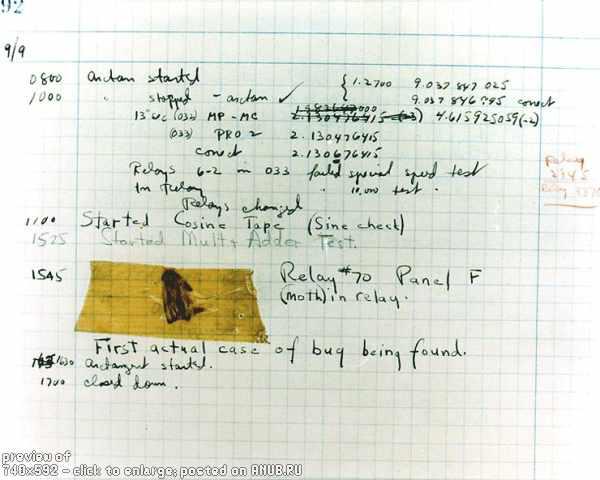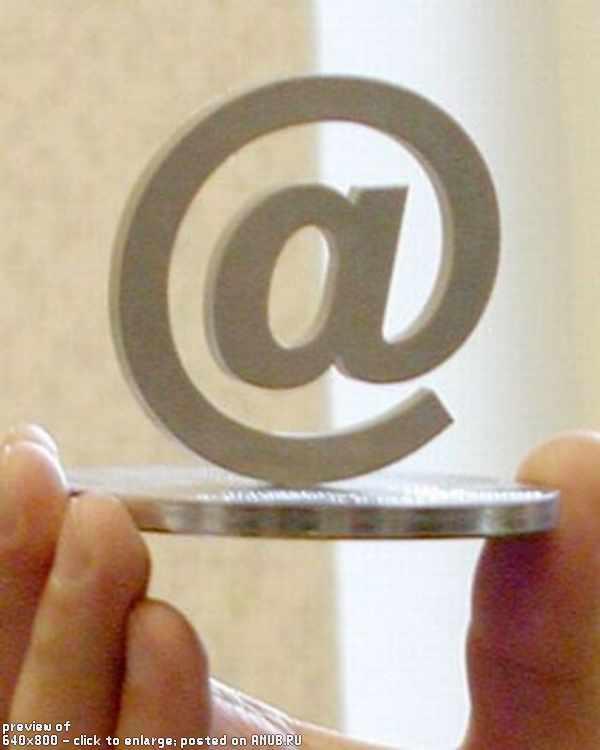650
September. Celebrate ...
The month of September for us, of course, is the beginning of a new school year, but September holidays do not end ... 
Day tester
September 9, 1945, scientists at Harvard University, to test the computing machine Mark II Aiken Relay Calculator, found a moth stuck between contacts of electromechanical relays.
Existing work required to describe, and the word was found - «debugging» (literally: to get rid of insects) - and now is the process of identifying and eliminating bugs - malfunction in the computer.
Extracted insect was pasted in tehdnevnik, with an accompanying inscription: "First discovered the bug," and later transferred to the Museum of Computing tehniki.Neizvestno notes whether America this auspicious day, while in Russia this unofficial holiday has taken root - the Day of the tester!
It looked like the first one detected bag.
Programmer's Day
September 13 (date to 2009)
Programmer's Day is celebrated on the 256th day of the year. Number 256 (two to the eighth power) is chosen because it is the number of integers that can be expressed using one byte. In leap years the holiday falls on September 12 in a non-leap - September 13.
Often the word "programming" and everything associated with it, the average person is associated only with a personal computer, but it is not. Virtually every electronic device - from remote control to complex industrial machines with programmed control - at one time passed through the hands of experts in programming.
We are faced with every hour labors that made the programmer. Whether we look TV, listening to any radio, you talk on the phone - we use the fact that the programmer created. Perhaps no other profession does not cover such a wide area of our lives.
24.07.09 Ministry of Communications and Mass Communications of the Russian Federation prepared and submitted to the Government a draft Decree of the President of Russia "On the Day of the programmer." And although it is still the holiday entirely virtual, the fruits of our labors glorious programmers is very, very real.

Birthday "Smiley»
For 25 years, Smiley became a fixture in the electronic communication
September 19, 1982, a professor at Carnegie Mellon University Scott Fahlman (Scott E. Fahlman) first proposed the use of three characters, consecutive - a colon, a hyphen and a closing parenthesis - to denote the "smiling face" in the text that is typed on the computer. It was a serious updating of the electronic lexicon.
History has preserved the very letter that Fahlman posted on local bulletin board, which was the prototype of today's forum, and at the time was the main means of communication between the staff of the University.
Here it is:
19-Sep-82 11:44 Scott E Fahlman :-) From: Scott E Fahlman I propose that the following character sequence for joke markers: :-) Read it sideways.
Actually, it is probably more economical to mark things that are NOT jokes, given current trends. For this, use :-(
Historical post was preceded by a long discussion, where the participants discussed the question of what characters should be used to indicate that the message is a humorous character. I must say that the report, which was first used by Smiley, was found only in 2002, in the archives of boards, which have been preserved on film. The "digital archaeological excavation", which were organized with the sole purpose to find the message and thereby determine the date of birth of the emoticon, participated a few enthusiasts.
For 25 years, Smiley became a fixture in the electronic communication, and to imagine how it would be possible without it, virtually impossible. It replaces what is lacking in communication via chat or e-mail - tone of voice and facial expressions. Emoticons help to better understand the interlocutor, to catch his mood, in the end, they are just funny and evoke positive emotions.
What emerged very smiley sign? In the middle of the last century, he lived in America the artist Harvey Bell. Nothing remarkable, his work was no different: much criticism they were not interested in his paintings hardly threatened immortality ...
But somehow he was approached by representatives of the insurance company «State Mutual Life Assurance Cos. of America »with a request to come up with some bright memorable character - a business card of the company.
Harvey did not have long thought, he took and offered to customers that now every single internet users called smiley - smiling face at himself. Customers have taken a job, Bella paid fifty dollars, produced badges with this mug and distributed to all the personnel of the company ... The success of such a "business card" has surpassed all expectations. The company's customers were delighted with the innovation - just a few months it was released more than ten thousand icons!
Soon cute smiley began to appear on T-shirts, baseball caps, envelopes, postcards, matchbooks. Even the US Post Office issued a stamp with this symbol.
Bella is literally bursting with pride. "Never in the history of art and not a single work, which would, spreading so widely, brought so much happiness, joy and pleasure. There was not anything made that simple, but has become obvious to all "- he said in one of his numerous interviews.
Later, Harvey Bell even invented a holiday - International Day of Smile (World Smile Day), who is celebrated on 1 October. He believed that this day should be devoted to the good mood.

Day of the Internet in Russia
International Day of the Internet trying to enter several times on different dates, but none of them did not become traditional.
In Russia caught on the date of September 30th. And it all started with the fact that Moscow company «IT Infoart Stars» sent to firms and organizations offer to support its initiative, which consists of two items: designate September 30, "Internet Day" each year to celebrate it and to conduct "a census the Russian-speaking Internet." At that time, the number of users has reached 1 million. People.
In 1998, the World Day of the Internet sanctioned by Pope John Paul II. The patron saint of the Internet has not yet been officially approved, but since 2000 the temporary patronage web has Isidore of Seville, the Spanish bishop, who lived in 560-636 years. He is considered the first encyclopedic, which has had a significant impact on the history of the Middle Ages. Therefore, in many countries around the world celebrated the feast Network April 4 - the day of the ascension of St. Isidore of Seville.
In many countries there are national days of the Internet. Typically, they are confined to some events related to the introduction of the Internet in this country.
In addition, January 27 the world community celebrates the "International Day without the Internet." The organizer of this festival are enthusiasts around the world, conducting their ideas through online community «Do Be» .

Day tester
September 9, 1945, scientists at Harvard University, to test the computing machine Mark II Aiken Relay Calculator, found a moth stuck between contacts of electromechanical relays.
Existing work required to describe, and the word was found - «debugging» (literally: to get rid of insects) - and now is the process of identifying and eliminating bugs - malfunction in the computer.
Extracted insect was pasted in tehdnevnik, with an accompanying inscription: "First discovered the bug," and later transferred to the Museum of Computing tehniki.Neizvestno notes whether America this auspicious day, while in Russia this unofficial holiday has taken root - the Day of the tester!
It looked like the first one detected bag.

Programmer's Day
September 13 (date to 2009)
Programmer's Day is celebrated on the 256th day of the year. Number 256 (two to the eighth power) is chosen because it is the number of integers that can be expressed using one byte. In leap years the holiday falls on September 12 in a non-leap - September 13.
Often the word "programming" and everything associated with it, the average person is associated only with a personal computer, but it is not. Virtually every electronic device - from remote control to complex industrial machines with programmed control - at one time passed through the hands of experts in programming.
We are faced with every hour labors that made the programmer. Whether we look TV, listening to any radio, you talk on the phone - we use the fact that the programmer created. Perhaps no other profession does not cover such a wide area of our lives.
24.07.09 Ministry of Communications and Mass Communications of the Russian Federation prepared and submitted to the Government a draft Decree of the President of Russia "On the Day of the programmer." And although it is still the holiday entirely virtual, the fruits of our labors glorious programmers is very, very real.

Birthday "Smiley»
For 25 years, Smiley became a fixture in the electronic communication
September 19, 1982, a professor at Carnegie Mellon University Scott Fahlman (Scott E. Fahlman) first proposed the use of three characters, consecutive - a colon, a hyphen and a closing parenthesis - to denote the "smiling face" in the text that is typed on the computer. It was a serious updating of the electronic lexicon.
History has preserved the very letter that Fahlman posted on local bulletin board, which was the prototype of today's forum, and at the time was the main means of communication between the staff of the University.
Here it is:
19-Sep-82 11:44 Scott E Fahlman :-) From: Scott E Fahlman I propose that the following character sequence for joke markers: :-) Read it sideways.
Actually, it is probably more economical to mark things that are NOT jokes, given current trends. For this, use :-(
Historical post was preceded by a long discussion, where the participants discussed the question of what characters should be used to indicate that the message is a humorous character. I must say that the report, which was first used by Smiley, was found only in 2002, in the archives of boards, which have been preserved on film. The "digital archaeological excavation", which were organized with the sole purpose to find the message and thereby determine the date of birth of the emoticon, participated a few enthusiasts.
For 25 years, Smiley became a fixture in the electronic communication, and to imagine how it would be possible without it, virtually impossible. It replaces what is lacking in communication via chat or e-mail - tone of voice and facial expressions. Emoticons help to better understand the interlocutor, to catch his mood, in the end, they are just funny and evoke positive emotions.

What emerged very smiley sign? In the middle of the last century, he lived in America the artist Harvey Bell. Nothing remarkable, his work was no different: much criticism they were not interested in his paintings hardly threatened immortality ...
But somehow he was approached by representatives of the insurance company «State Mutual Life Assurance Cos. of America »with a request to come up with some bright memorable character - a business card of the company.
Harvey did not have long thought, he took and offered to customers that now every single internet users called smiley - smiling face at himself. Customers have taken a job, Bella paid fifty dollars, produced badges with this mug and distributed to all the personnel of the company ... The success of such a "business card" has surpassed all expectations. The company's customers were delighted with the innovation - just a few months it was released more than ten thousand icons!
Soon cute smiley began to appear on T-shirts, baseball caps, envelopes, postcards, matchbooks. Even the US Post Office issued a stamp with this symbol.
Bella is literally bursting with pride. "Never in the history of art and not a single work, which would, spreading so widely, brought so much happiness, joy and pleasure. There was not anything made that simple, but has become obvious to all "- he said in one of his numerous interviews.
Later, Harvey Bell even invented a holiday - International Day of Smile (World Smile Day), who is celebrated on 1 October. He believed that this day should be devoted to the good mood.

Day of the Internet in Russia
International Day of the Internet trying to enter several times on different dates, but none of them did not become traditional.
In Russia caught on the date of September 30th. And it all started with the fact that Moscow company «IT Infoart Stars» sent to firms and organizations offer to support its initiative, which consists of two items: designate September 30, "Internet Day" each year to celebrate it and to conduct "a census the Russian-speaking Internet." At that time, the number of users has reached 1 million. People.
In 1998, the World Day of the Internet sanctioned by Pope John Paul II. The patron saint of the Internet has not yet been officially approved, but since 2000 the temporary patronage web has Isidore of Seville, the Spanish bishop, who lived in 560-636 years. He is considered the first encyclopedic, which has had a significant impact on the history of the Middle Ages. Therefore, in many countries around the world celebrated the feast Network April 4 - the day of the ascension of St. Isidore of Seville.
In many countries there are national days of the Internet. Typically, they are confined to some events related to the introduction of the Internet in this country.
In addition, January 27 the world community celebrates the "International Day without the Internet." The organizer of this festival are enthusiasts around the world, conducting their ideas through online community «Do Be» .

























